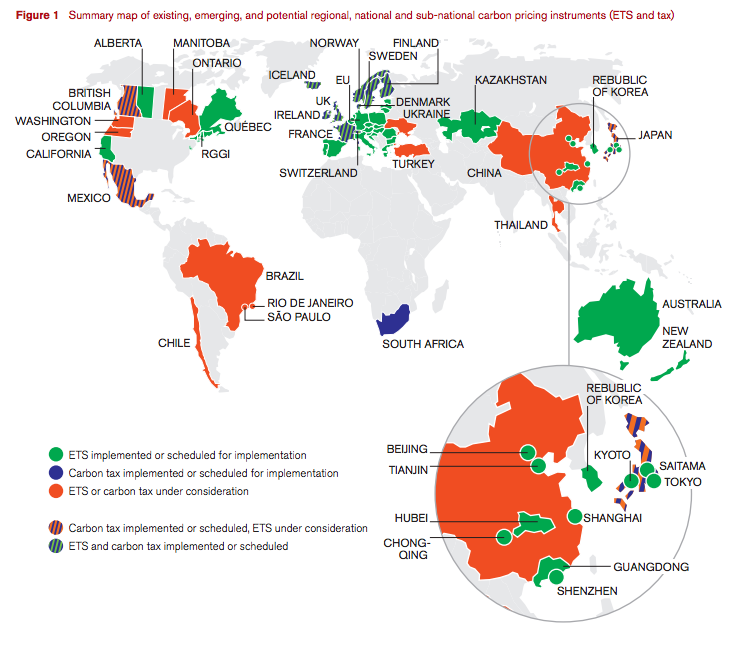
The state of carbon pricing: Around the world in 46 carbon markets
Mat Hope
05.29.14Mat Hope
29.05.2014 | 4:20pmCarbon markets, designed to make polluters pay and reduce emissions, are more common than ever. But the economic slump and the structural flaws mean they’re stumbling, a new report suggests. We take a whistlestop tour of the schemes.
As eight new markets opened in 2013, and both the US and China established programmes, there was some hope that carbon pricing was coming of age. But only 12 per cent of the world’s emissions are covered by the projects. And the last 12 months have been tough for some flagship schemes.
Nonetheless, the World Bank’s annual review of carbon markets shows they are now present on almost all the world’s continents in some form:

Europe
Some European countries have a carbon tax where the government sets a price for each tonne of carbon dioxide emitted. Others have cap-and-trade systems where the governing body sets a gradually reducing limit on emissions covered by the scheme, and let the market set the price.
The European Union’s emissions trading scheme (ETS) is the world’s largest cap-and-trade scheme, covering about half the bloc’s carbon dioxide emissions. But the ETS has hit trouble in recent years.
The European Commission scrambled to boost the price after it plummeted to record lows in 2013. Its plan to temporarily remove 900 million permits – known as backloading – is only a temporary fix, however.
The commission has introduced a new proposal that would allow it to tinker with the number of permits, known as a strategic reserve. But experts remain unconvinced the reform would be able to save the market.
A number of domestic schemes have popped up to bolster the EU-ETS.
The UK introduced a carbon price floor in 2012 which put a minimum price on emissions. But the media blamed it and other green levies for high consumer bills, leading the UK Chancellor to curb the policy.
Sweden also has its own carbon tax. With a price of $168 per tonne of carbon dioxide, it has the highest carbon price in the world. A number of industries – such as those not covered by the EU ETS and agriculture – are partially exempt from the tax, however, limiting its effect.
France and Ireland also have limited taxes on the use of fossil fuels.
US
America’s Congress has failed on numerous occasions to establish a nationwide cap-and-trade programme. But it does have two regional schemes.
The Regional Greenhouse Gas Initiative (RGGI) covers nine states: Connecticut, Delaware, Maine, Maryland, Massachusetts, New Hampshire, New York, Rhode Island and Vermont. California also has its own scheme.
While symbolically important, the RGGI isn’t particularly ambitious – the carbon price is consistently between $2 to $3. California’s market has fared slightly better, with a carbon price of around $10 to $15 during its first full year of trading. Both schemes show a desire for climate action in the US at the sub-national level which the national government has so far struggled to match.
President Obama is expected to make an announcement on Monday which could strengthen the schemes, however. A new rule capping coal emissions could encourage states to join existing cap-and-trade schemes or set up their own.
China
Perhaps the biggest news in the carbon trading world this year was the start of six regional cap-and-trade schemes in China. 1,115 megatonnes of carbon dioxide emissions are covered by the schemes, making China the second largest carbon market in the world.
Each of the schemes is slightly different, with the carbon price fluctuating between ¥20 ($3) and ¥80 ($13). China’s national government is hoping to learn which works best before rolling out a nationwide programme, possibly as early as 2016, the World Bank reports.
Australia
In contrast to China’s exciting early success, a change of government has seen Australia’s carbon market implode.
Tony Abbott was elected as Australia’s prime minister in 2013 on a largely climate skeptic platform. A centrepiece of his Liberal Party’s environmental policy is to scrap Australia’s carbon tax and stop its planned integration into the EU ETS. Instead, the government wants to implement a ‘Direct Action Plan’ in which companies ‘bid’ to reduce emissions.
The proposal switches the emphasis of Australia’s emissions reduction policies to paying businesses to curb emissions, rather than taxing their pollution. Experts remain unconvinced by the plans economic or environmental credentials, however.
Pricing problems
All in all, it’s been a mixed 12 months for global carbon markets. For every Chinese success, there’s been an Australian-style failure. And for every new market, a flagship scheme has faltered.
While many politicians and policy analysts continue to see carbon pricing as a core part of global efforts to reduce emissions, existing markets have structural frailties. These problems often keep prices low and limit their ability to reduce emissions.
Part of the problem was that when the global economy crashed, energy demand plummeted. That led to a surplus of permits in carbon trading schemes, pushing prices down and letting many polluters off the hook. This led to a belated recognition that governing bodies needed some sort of control over the amount of permits in trading schemes – and therefore the carbon price – if they are going to be effective. Hence the EU ETS reforms.
And unless a global carbon market is established, there’s always a danger polluters will just move from a region with a high carbon price, to a market with a lower price, or no price at all. A problem known as carbon leakage.
The World Bank says a strong international treaty in 2015 would help revive interest in a global carbon market. As negotiators work hard to try and make that happen, existing schemes will continue to bear the carbon pricing load with variable levels of success.

